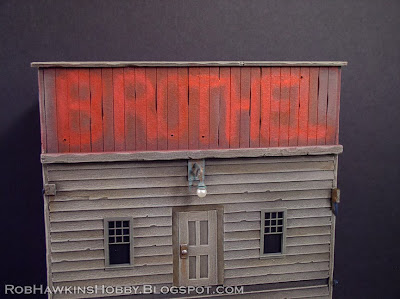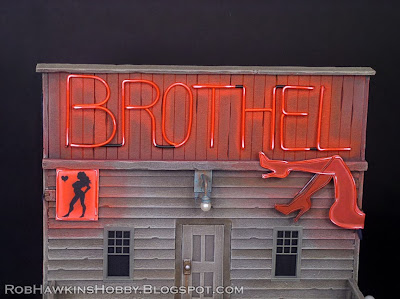Terrain Tutorial: Neon Signs
Here's how I create the ubiquitous neon signs for the Wild West Exodus terrain. This technique would also work for contemporary and sci-fi settings.
What you will need:
Heavy gauge floral wire
Pin vise and drill bit (same size as floral wire)
Clippers
Needle nose pliers (with flat jaws)
Constructing the Sign
The round floral wire will form the "glass tubing" of the neon sign. It can be bent into letters or different shapes. Use needle nose pliers to bend the wire. It's important that the pliers have flat jaws, as serrated jaws will mar the smooth surface of the wire. It helps to plan the path of the wire so the letters can flow in one long line without too many overlaps or doubling up. The pliers will also help you get clean 90-degree bends.
For a lettered sign, begin at one end and work your way to the right. Start with a 1/4-inch section that will insert into the back of the sign, and build the letter from there.
The rounded sections, like this B can be bent by hand.
Where the middle of the B bends, use the pliers to fold the wire back over itself, and then squeeze the two sections together.
Do the same at the bottom of the B and bring the wire over to the next letter. Try your best to get consistent spacing and height to the letters. Practice makes perfect!
On larger signs, the word may need to be broken into sections if the wire isn't long enough. Here, the word brothel has been broken into "BRO" and "THEL." There is an attachment point at the end of each section, in this case at the bottoms of the B, O, T, and the top of the L.
Fit your letters as you work to avoid running out of space. It may help to draw a pattern on a piece of paper the same size as your sign, and match the wire letters to what you've drawn.
Once the wire work is finished, mark the attachment positions on the sign, and drill holes with a pin vise. Fit the sign in place, but do not glue it yet. In this shot, below the main, sign you can see the legs and sign frame that were outlined with thin wire to make the neon shapes. The sky's the limit to what you can do!
Painting the Sign
Drill holes in popsicle sticks and lightly glue the neon letters in place. Spray them with white primer, and you're ready to begin painting.
Since this is a red neon sign, that's the color I'm working with in this tutorial. You can use whatever color you like for your signs, the process remains the same.
Start by basecoating the letters with red.
Be sure to get clean, smooth coverage with no white showing through.
For the next step, mix a little white into the red. Just use enough to lighten the red without turning it pink. Brush this mid tone over the corners and upper curves of the letters.
Finally, apply a straight white lighlight line on the corners and ends.
Create the separations between the letters by blacking out the negative spaces just like on a real neon sign.
Any of the sign that passes behind the letter should be blacked out.
Here are the finished neon letters:
Painting the Glow
Once the building and the letters are painted, it's time to add the glow on the sign itself.
Start by painting a dark glaze over the area, blended out at the edges. To darken the red, I added a little P3 Sanguine Red.
Before the glaze dries, pull out some of the color where the open areas of the letters will be. It's important to note that from here on, you should let each layer of color dry completely before moving to the next step. Otherwise the blending can pull up the layer of paint underneath.
Use the letters as a guide, and paint a lighter version of the letters on the sign. I used straight red, thinned a little. You can see it running into the cracks between the boards. Before the paint dries, diffuse the edges with a dry brush, and pull any of the color out of the recesses where it may have gotten out of control.
It's a bit of an organic process. An airbrush might make things a little easier.
Once you're satisfied with the letter glow, add a little white to the red and paint it into the centers of the letters. Things may get a little pink, but that's okay.
To finish everything up, apply a thin glaze of red over the entire area. This will tone down the pink, and brighten the background a little, leafing a nice impression of the sign's glow.
All that remains is to glue the neon letters in place!
Similar techniques are used on the smaller signs and the glow around them. Experiment with different colors and thicknesses of wire. Above all, have fun!
'Til next time!






























Holy crap, that's cool! Thanks for sharing that with us.
ReplyDeleteAn excellent class! I'm gonna put a brothel in all my dioramas! XD
ReplyDeleteBrilliant. Love it
ReplyDeleteLooks great, very original. Thank you for the tutorial!
ReplyDeleteWow. Very helpful. Thanks a lot!
ReplyDeleteAwesome! I love it.
ReplyDeleteI've been waiting for this tutorial! Great stuff.
ReplyDeleteFantastic! I like it so much, thanks for sharing!
ReplyDeletePhil.
That actually made me smile :)) Thanks for posting this!
ReplyDeleteGlad everyone enjoyed the tutorial. Thanks!
ReplyDeleteFantastic tutorial. Thanks for posting.
ReplyDeleteThis is Brilliant! Totally Brilliant!!!!
ReplyDeleteA great tutorial - thank you for posting it.
ReplyDeleteTony
That's superb.
ReplyDeleteJohn T
Very clever!
ReplyDeleteThis is a really cool idea and helpful tutorial. Great blog too. Would you mind if I share some of your work on my blog if I accredit and post links?
ReplyDeleteThanks, Shay! I don't mind if you share or link to my blog. Just please don't republish it (via copy & pasting the article content, for example).
DeleteLooks brilliant. Excellent work. Here I was thinking you had used light strips, because it looked so convincing. The lo-fi solution is often the best!
ReplyDeleteThis would be an excellent article to submit to Model Railroader magazine. They also pay for published submissions. Very useful for a variety of periods of railroads, as well as gaming.
ReplyDeleteGenius.
ReplyDeleteAwesome. Thanks for sharing!
ReplyDeleteGreat stuff! Nice tutorial.
ReplyDelete